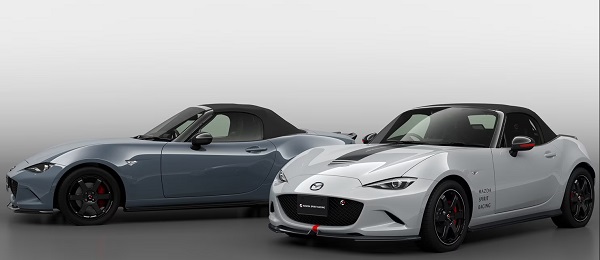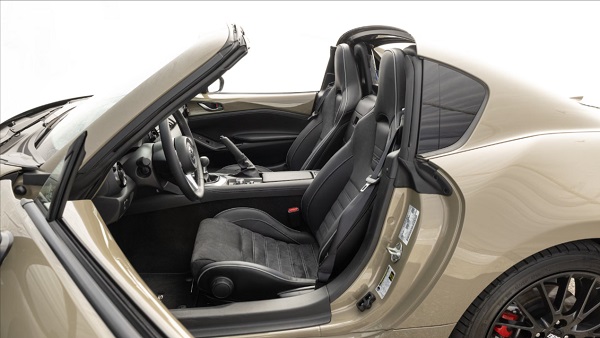Are we resentful? Perhaps, but it seems we are. Mazda has a commendable track record of emphasizing moderate power and light weight in the MX-5. The current ND-generation Miata is one of the few contemporary vehicles that weighs less than its direct predecessor. However, when Mazda announces a special, enhanced Miata with a substantial increase in power, distinctive aerodynamic components, suspension modifications, and a focus on track performance, it’s hard not to feel disappointed.
Because it’s not intended for us. In reality, it won’t cater to many people at all. The new Mazda Spirit Racing Roadster 12R will be limited to only 200 units, and it will be available exclusively in Japan. A less modified version, the Spirit Racing Roadster, as well as the Roadster RF, will also be released, featuring a lower-output engine. Both models are equipped with a 2.0-liter I-4, with the non-12R variant producing 181 hp. They share some similar enhancements, such as ventilated Brembo brakes, tuned Bilstein dampers, a thicker tunnel brace, special RAYS wheels modeled after those used by Super Taikyu race cars, and optimized aerodynamic parts designed to reduce drag and increase downforce, according to Mazda.
The exterior of the 12R, pictured here in concept form before production, showcases a stylish Aero Gray paint job with a darker gray on the aerodynamic parts. It also features some unique decals that are likely to be included in the final production version. The design draws inspiration from other Mazda Spirit Racing vehicles, like the alternative-fuel CNG racer and the visually striking Club racer.

Now, onto the exciting details: what will the 12R’s power output be? Mazda has evidently invested significant effort into the engine, featuring a modified cylinder head, a unique cam profile, an altered exhaust manifold, along with enhanced intake and exhaust systems. While the power curve isn’t specified, given the 12R’s track orientation, we assume that gains occur primarily at higher RPMs. There is no mention of changes to the gearing or rear end.
Perhaps the engine modifications might struggle to meet stringent U.S. emissions regulations, but it’s still tough to look at the Mazda Spirit Racing Roadster twins and not wish for a return of the legendary R Package cars in the U.S. market, ideally with power enhancements.
Mazda introduced the MX-5 Spirit Racing 12R at the 2025 Tokyo Auto Salon – a limited-edition model developed in partnership with Mazda Spirit Racing. Boasting increased power, refined suspension, and subtle aerodynamic upgrades, it represents the most performance-oriented version of the ND-generation roadster thus far.
The 2025 Tokyo Auto Salon continues to unveil enticing offerings, this time coming from the Hiroshima region. The ND Mazda MX-5 is about to mark its tenth anniversary in production, yet this classic roadster shows no signs of losing momentum. In fact, with 197bhp, the limited-edition 12R is set to be the fastest factory-built MX-5 ever produced.
The in-house performance division, Mazda Spirit Racing, played a key role in the vehicle’s development, employing insights gained from the Super Endurance series. The additional 16bhp comes from classic tuning techniques: including a new air intake, upgraded cams, a restructured cylinder head and exhaust manifold, new pistons, and even a custom crankshaft. The vehicle also features a distinctive JDM-style single-exit exhaust. Alongside the power enhancements, a more robust radiator boosts durability for track days.
A single look at the 12R confirms Mazda’s intentions with this vehicle, which is noticeably lower thanks to adjustable Bilstein dampers combined with new springs. This aggressive profile is complemented by forged RAYS TE37 wheels fitted with semi-slick Yokohama Advan AD09 tires. Behind these are Brembo four-pot calipers equipped with track-focused pads and discs. To enhance rigidity, Mazda has added a thicker tunnel brace.
The lowered stance is matched by a subtle body kit that includes a redesigned front apron, new side skirts, and a split-level ducktail spoiler. Mazda Spirit Racing decals contribute to the vehicle’s visual assertiveness; however, given that two 12Rs were showcased at the event—one with decals and one without—it appears their inclusion will be optional. Inside the cabin, Alcantara-trimmed Recaro seats with Spirit Racing four-point harnesses and an Alcantara-covered steering wheel enhance the overall experience.
All of this culminates in a comprehensive upgrade of the ND MX-5, with production limited to just 200 units—all confined to the Japanese domestic market. Each unit will be a roadster featuring a fabric roof, making it the lightest version available. Priced at ¥7m (approximately £36,000 at the current exchange rate), the first 12Rs are expected to be delivered to customers in the third quarter of 2025. Let’s hope some make their way to the UK via grey market imports.
Mazda has unveiled the MX-5 Spirit Racing 12R at the 2025 Tokyo Auto Salon, a special edition created in collaboration with Mazda Spirit Racing. This model boasts enhanced power, improved suspension, and subtle aerodynamic tweaks, making it the most performance-oriented version of the ND-generation roadster to date.
The 2025 Tokyo Auto Salon continues to showcase its enticing offerings, with this latest one originating from the Hiroshima Prefecture. The ND Mazda MX-5 is about to mark its tenth year of production, yet this iconic roadster shows no signs of diminishing appeal. In fact, with 197bhp, the limited-edition 12R holds the title of the quickest factory-built MX-5 ever made.
Mazda’s in-house performance division, Mazda Spirit Racing, has played a significant role in the vehicle’s creation, utilizing insights gained from the Super Endurance series. The boost of 16bhp comes from traditional tuning methods: a new air intake, upgraded camshafts, a fresh cylinder head and exhaust manifold, new pistons, and even a custom crankshaft. Additionally, the vehicle features a distinctive JDM-style single-exit exhaust system. To enhance track-day reliability, it is equipped with an upgraded radiator.
A single glance at the 12R showcases Mazda’s ambitions for this model, which is notably lower thanks to adjustable Bilstein dampers and new springs. The aggressive stance is further highlighted by forged RAYS TE37 wheels fitted with semi-slick Yokohama Advan AD09 tires. Behind the wheels, Brembo four-pot calipers grip track-oriented pads and discs. To enhance rigidity, Mazda has also incorporated a thicker tunnel brace.
The lowered profile is accentuated by a subtle bodykit that includes a modified front apron, updated side skirts, and a split-level ducktail spoiler. Mazda Spirit Racing decals contribute to the sporty appearance, though it seems that buyers can opt for them, as shown by the two 12Rs presented at the event—one adorned with the decals and the other without. Inside the cabin, you will find Recaro seats wrapped in Alcantara equipped with Spirit Racing four-point harnesses, along with an Alcantara-covered steering wheel.
Overall, this represents a comprehensive update to the ND MX-5, with production limited to just 200 units—all destined for the Japanese domestic market. Each unit will be a roadster featuring the lightweight fabric roof. Priced at ¥7m (approximately £36,000 at current exchange rates), the initial deliveries of the 12R are expected to reach customers in Q3 2025. Let’s hope some of these models make their way to the UK through grey import channels.
The MX-5 Miata embodies Mazda’s car-making principle, “Jinba Ittai,” which translates to horse and rider as one, representing the enjoyable driving experience that engineers have aimed to create since the vehicle was first conceived. Since its launch in 1989, this model has continually delivered driving pleasure unique to a lightweight sports car and has garnered appreciation from individuals across various nations, cultures, and ages.
Unveiled at the Chicago Auto Show in February 1989, the initial MX-5 (NA) became available for purchase in the United States that May as a 1990 model. The NA rightfully earned its status as a “lightweight sports car,” tipping the scales at just over 2,000 pounds, and its immediate popularity inspired other manufacturers to develop their own open-top sports cars.
The second generation MX-5 (NB) was introduced at the Tokyo Motor Show in 1997 and was released as a 1999 model year. The NB featured several limited editions, including a high-performance turbocharged version and a coupe variant in Japan. In 2000, the MX-5 was acknowledged by Guinness World Records as the all-time best-selling convertible two-seater sports car.
Debuting at the Geneva International Motor Show in 2005, the third generation MX-5 (NC) was equipped with a 2.0-liter engine for the first time. The following year, a retractable hardtop version joined the lineup, making the joys of open-top driving more accessible to a broader audience and winning over fans globally.
The most recent version of the MX-5, the fourth generation (ND), was revealed in the United States in September 2014. Production of this model hit one million units almost exactly twenty-seven years after the inaugural MX-5 came off the assembly line.
Recently, Mazda launched the new ND hardtop variant as the 2017 Mazda MX-5 RF (Retractable Fastback). With this striking iteration of the MX-5, Mazda remained committed to the hardtop’s objective of enhancing open-top driving accessibility, while also breaking away from conventional approaches. By taking on new challenges, they crafted a vehicle that provides an exhilarating open-air experience with the top down, yet boasts stunning fastback aesthetics when the roof is closed.
Now offering two distinct MX-5 models, Mazda aims to share the joy of convertible sports cars with a wider audience, helping more individuals to enjoy fulfilling and fun-filled lives.
Although lightweight sports cars have existed for decades, Mazda revitalized interest in them during the early ’80s. For Mazda, there were specific criteria for creating a lightweight sports car: it needed to have an open body with a snug cockpit, ideal weight distribution, a double-wishbone suspension, and it had to conform to the driver like a glove. This narrative originated from a casual remark made by an automotive journalist regarding Mazda’s iconic MX-5 Miata.

PRELUDE
In the late ‘70s, Bob Hall began a new chapter in his career as an automotive journalist at Motor Trend. Having spent considerable time in Japan as a teenager, he developed a proficiency in Japanese, allowing him to serve as the Los Angeles correspondent for Motor Fan, a Japanese automotive magazine.
Hall had always been surrounded by fascinating cars. His father was a true car enthusiast, owning European brands like MG, Triumph, Austin-Healey, and Alfa Romeo—the quintessential examples of lightweight and simple open-top sports cars. However, the era Hall found himself in as a young writer was witnessing the decline of these vehicles, with emissions and safety regulations dominating the headlines.
The Japanese manufacturers promptly responded to these changing circumstances by producing reliable and efficient vehicles that were embraced by Americans. Hall observed this shift firsthand and grew to admire how Mazda continued to develop sporty models powered by rotary engines. He often thought about how appealing it would be to have a car that fused Japanese reliability and technology with the enjoyable experience provided by British sports cars.
CHALKBOARD MEETING
In April 1979, Hall had the chance to visit Mazda’s headquarters in Hiroshima. There, he was able to share his vision for an ideal automobile with Kenichi Yamamoto, who was then the head of Mazda’s Research and Development, illustrating his concept on a chalkboard and adding notes while explaining the feasibility of creating a convertible using parts from the contemporary Familia (known as the 323 or GLC), which featured a front-engine, rear-wheel-drive layout.
Following their meeting, Hall had dinner with Yamamoto, though the topic of the lightweight sports car didn’t arise. Undeterred, he recommended that Yamamoto should experience driving a Triumph Spitfire at some point. Eventually, the Japanese engineer took a drive in the Spitfire along the scenic roads near Hakone. The rest, as they say, is history…
EARLY DEVELOPMENT: THE OGG PROJECT
The MX-5 Miata project truly began with what was known as the OGG program. Before the days of the roadster, Mazda’s primary vehicles in Japan included the Familia (323), Capella (626), Luce (929), RX-7, and the Bongo minivan. These were categorized as ‘On-Line’ vehicles, but it quickly became clear that more models were necessary to expand market share and reach different market segments.
Attractive new products with unique personalities were essential, and the OGG project was established to channel innovative ideas into a prototype phase. OGG stood for ‘Off-Line Go-Go’, where the ‘off-line’ aspect indicated an experimental approach, while the latter part symbolizes the Japanese number 55. This number is important as any project initiated under this new framework needed a minimum 55 percent likelihood of success as a production vehicle to move forward. This approach sensibly balanced creativity with practical expectations.
Starting in November 1983, Mazda’s research and development team outlined the necessity for a small 660cc vehicle, a utility van, and potentially a lightweight sports car to fit beneath the RX-7. This led to the creation of the Carol kei-car, the very successful Mazda MPV, and an open car poised to become a global sensation – the MX-5 Miata.
PROGRESS
As Mazda began to envision what a lightweight sports car might resemble, the company’s two regional R&D centers engaged in a “competition of design centers.” Each center worked on their own interpretation of a lightweight sports car and presented these designs to a broader audience in Hiroshima. Mazda’s Tokyo studio focused on the front-wheel drive and mid-engine coupe concepts, while the U.S. R&D team worked on the rear-wheel drive convertible concept. The full-scale models underwent two rounds of evaluations in 1984, ultimately resulting in the triumph of the U.S.-based R&D team’s design.
MASS-PRODUCTION DEVELOPMENT
With Kenichi Yamamoto stating, “this car has an aura of culture,” Toshihiko Hirai was named the Project Program Manager in February 1986 with the responsibility of bridging the significant gap between the prototype’s imaginative concepts and the tough realities of preparing them for mass production. Hirai, a dedicated engineer, was ideally suited for this challenging task. His involvement marked a significant advancement in making the MX-5 Miata a tangible product.
Even though many engineers were committed to other urgent projects within Mazda’s vehicle lineup, Hirai managed to form a team where possible and urged them to push beyond their conventional skill sets.
Hirai’s principal rule for the team was to never make compromises. He developed Mazda’s renowned Jinba-ittai philosophy, which embodies the unity of horse and rider, and encouraged his team to create a lightweight sports car that featured the most captivating driving dynamics. Hirai and his team were adamant that the vehicle be lightweight with evenly distributed weight across the front and rear axles, possess a low center of gravity, an engine placed as far back as feasible, a double-wishbone suspension, and a user-friendly soft top. These specifications would persist through each generation of the MX-5 Miata, remaining true to Hirai’s commitment.


